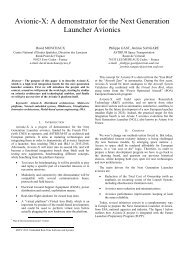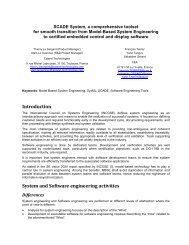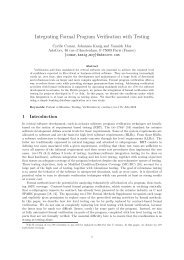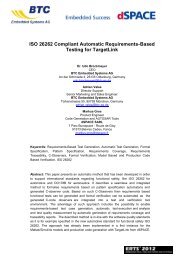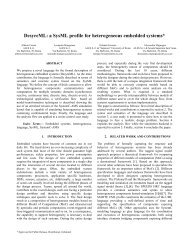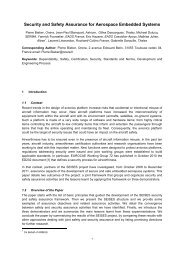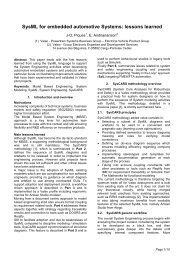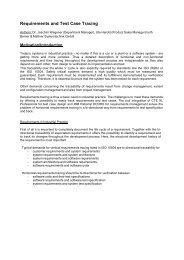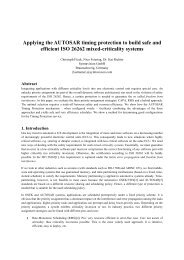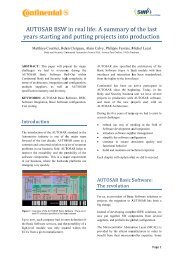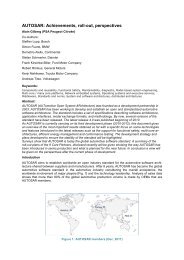A Simulator based on QEMU and SystemC for Robustness ... - SEE
A Simulator based on QEMU and SystemC for Robustness ... - SEE
A Simulator based on QEMU and SystemC for Robustness ... - SEE
You also want an ePaper? Increase the reach of your titles
YUMPU automatically turns print PDFs into web optimized ePapers that Google loves.
• User mode emulati<strong>on</strong>. In this mode, <strong>QEMU</strong> can launch<br />
processes (not OSes) compiled <strong>for</strong> <strong>on</strong>e CPU <strong>on</strong> another<br />
CPU, whereas compatibility is needed between the applicati<strong>on</strong><br />
<strong>and</strong> the hosting operating system where <strong>QEMU</strong> is<br />
running.<br />
To implement the full system emulati<strong>on</strong>, <strong>QEMU</strong> provides a set<br />
of predefined system plat<strong>for</strong>ms, characterized by a particular<br />
instructi<strong>on</strong> set architecture <strong>and</strong> by a set of emulated devices.<br />
The list of system plat<strong>for</strong>ms includes (but is not limited to) a<br />
PC system <str<strong>on</strong>g>based</str<strong>on</strong>g> <strong>on</strong> the x86 emulator, a PREP or PowerMac<br />
PowerPC system with a PowerPC cpu, a UltraSPARC machine<br />
<str<strong>on</strong>g>based</str<strong>on</strong>g> <strong>on</strong> sparc64, several boards <str<strong>on</strong>g>based</str<strong>on</strong>g> <strong>on</strong> ARM. The emulated<br />
devices available <strong>for</strong> each plat<strong>for</strong>m can be binded to host<br />
devices, redirected to files, or c<strong>on</strong>figured to be accessible from<br />
other processes in the host system, e.g., by sockets.<br />
B. Desyre<br />
The Desyre framework [4] is a <strong>SystemC</strong>-<str<strong>on</strong>g>based</str<strong>on</strong>g> virtual prototyping<br />
envir<strong>on</strong>ment. In this framework, the virtual prototype<br />
is composed of a set of modeling comp<strong>on</strong>ents, instantiated<br />
out of model libraries which may cover functi<strong>on</strong>al <strong>and</strong> architectural<br />
aspects of the system (e.g., protocol models, communicati<strong>on</strong><br />
channels, computati<strong>on</strong>al plat<strong>for</strong>ms). The virtual<br />
prototype is specified as a hierarchical netlist with a set of<br />
parameterized c<strong>on</strong>figurati<strong>on</strong> input files, compliant to the IP-<br />
XACT <strong>for</strong>mat [17]. These files define <strong>and</strong> instantiate the<br />
model comp<strong>on</strong>ents, <strong>and</strong> c<strong>on</strong>nect them together to specify the<br />
model of the entire system. To facilitate the generati<strong>on</strong> of the<br />
system netlists <strong>for</strong> complex designs <strong>and</strong> <strong>for</strong> the design space<br />
explorati<strong>on</strong>, Desyre provides an explorati<strong>on</strong> language (EL) to<br />
describe in a more c<strong>on</strong>cise <strong>for</strong>m, as parameter sets <strong>and</strong> parameter<br />
relati<strong>on</strong>s, the different c<strong>on</strong>figurati<strong>on</strong>s to be simulated.<br />
The EL specificati<strong>on</strong> is used to automatically generate <strong>and</strong><br />
parameterize the IP-XACT file sets, representing the selected<br />
scenarios. The designer has the freedom to run selectively<br />
the simulati<strong>on</strong> of a scenario or of all scenarios as a batch<br />
explorati<strong>on</strong>. A simulati<strong>on</strong> is per<strong>for</strong>med in three phases:<br />
1) Netlist elaborati<strong>on</strong> <strong>and</strong> comp<strong>on</strong>ent loading;<br />
2) Simulati<strong>on</strong>;<br />
3) Data post-processing <strong>and</strong> visualizati<strong>on</strong>.<br />
The first two phases are repeated <strong>for</strong> each of the chosen<br />
scenarios. In the elaborati<strong>on</strong> <strong>and</strong> loading phase, according<br />
to the designer’s netlists, the model builder of DESYRE<br />
dynamically creates in memory the system model by parsing<br />
the IP-XACT files <strong>and</strong> loading the required <strong>SystemC</strong> models<br />
(compiled <strong>and</strong> present in the library). In simulati<strong>on</strong>, the created<br />
system model is executed <strong>and</strong> the output traces are produced.<br />
In the data post-processing, traces are analyzed to aggregate<br />
<strong>and</strong>/or verify the per<strong>for</strong>mance <strong>and</strong> the functi<strong>on</strong>al data.<br />
The dynamic technique <strong>for</strong> the model creati<strong>on</strong> facilitates<br />
the design space explorati<strong>on</strong> by 1) removing the need <strong>for</strong><br />
the compilati<strong>on</strong> of the different <strong>SystemC</strong> netlists (the flow<br />
is compiler free); 2) enabling the designer to quickly derive<br />
additi<strong>on</strong>al scenarios by parameterizing the EL or IP-XACT<br />
files.<br />
DESYRE<br />
Fig. 1.<br />
<strong>QEMU</strong><br />
nic1<br />
netif IP<br />
(1)<br />
...<br />
Process<br />
instantiati<strong>on</strong><br />
nicN<br />
Exec<br />
loop<br />
ttyS0<br />
... netif IP<br />
qemu IP<br />
(N)<br />
Network model<br />
adapter<br />
Interface between <strong>QEMU</strong> <strong>and</strong> Desyre<br />
C. Architecture of the Desyre - <strong>QEMU</strong> integrati<strong>on</strong><br />
Desyre <strong>and</strong> the <strong>QEMU</strong> instances run as distinct processes<br />
<strong>on</strong> a Linux host system. <strong>QEMU</strong> is c<strong>on</strong>figured in full system<br />
emulati<strong>on</strong> mode, with a parametrized number of network<br />
interfaces <strong>and</strong> a serial port. The creati<strong>on</strong> of the multi-process<br />
envir<strong>on</strong>ment is managed through Desyre, <strong>and</strong> is <str<strong>on</strong>g>based</str<strong>on</strong>g> <strong>on</strong> a<br />
descripti<strong>on</strong> of the system model in the IP-XACT metamodel.<br />
The interacti<strong>on</strong> with an external <strong>QEMU</strong> process is managed<br />
by an adapter (Figure 1), composed of the following Desyre<br />
modules:<br />
• A qemu IP, which is resp<strong>on</strong>sible <strong>for</strong> instantiating a<br />
<strong>QEMU</strong> process at the simulati<strong>on</strong> start-up. During the<br />
simulati<strong>on</strong>, the module schedules the executi<strong>on</strong> of the<br />
<strong>QEMU</strong> instance <strong>and</strong> keeps the internal time of <strong>QEMU</strong><br />
synchr<strong>on</strong>ized with the Desyre time. The module may also<br />
issue the executi<strong>on</strong> of a comm<strong>and</strong> at a particular time in<br />
the c<strong>on</strong>sole of the guest operating system, accessed by<br />
the emulated serial port (ttyS0 in Figure 1) c<strong>on</strong>nected<br />
to a socket. At the end of the simulati<strong>on</strong>, it per<strong>for</strong>ms<br />
the shutdown of the virtual machine <strong>and</strong> collects the<br />
(eventual) logs generated inside the virtual machine <strong>and</strong><br />
stored <strong>on</strong> the virtual disk. The c<strong>on</strong>figurati<strong>on</strong> of <strong>QEMU</strong><br />
(parameter values <strong>and</strong> emulated devices to be instantiated)<br />
is captured in the IP-XACT files, as parameters of<br />
the <strong>QEMU</strong> IP.<br />
• A netif IP, which acts as an adapter between the emulated<br />
network interface card in <strong>QEMU</strong> <strong>and</strong> the model of the<br />
network in Desyre.<br />
Notice that the partiti<strong>on</strong>ing of the functi<strong>on</strong>alities in two<br />
different modules keeps the <strong>QEMU</strong> IP orthog<strong>on</strong>al from the<br />
particular model being interfaced with <strong>QEMU</strong>, <strong>and</strong> permits<br />
reusing this IP when different or additi<strong>on</strong>al parts of the systems<br />
(e.g., node peripherals) will be captured in Desyre.



